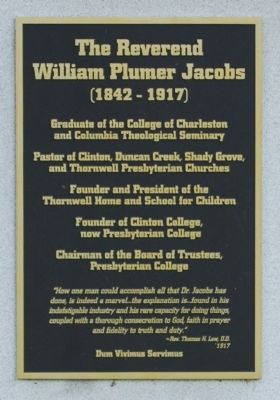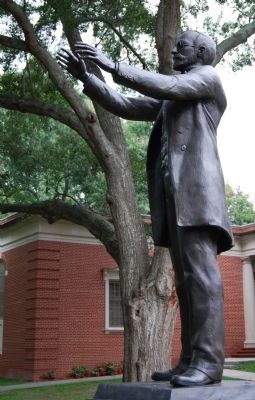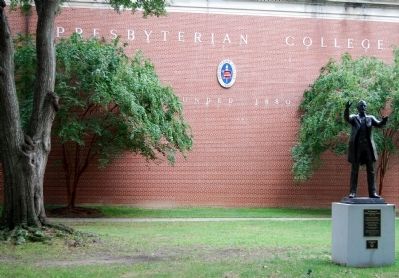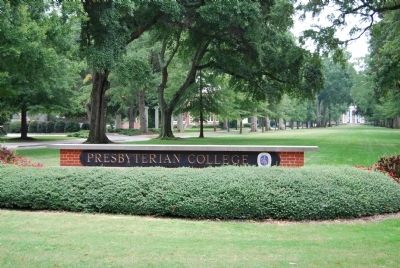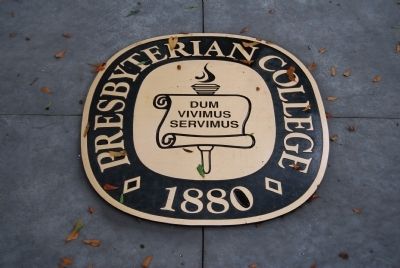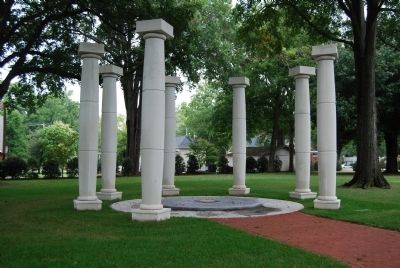Clinton in Laurens County, South Carolina — The American South (South Atlantic)
The Reverend William Plumer Jacobs
(1842-1917)
and Columbia Theological Seminary
Pastor of Clinton, Duncan Creek, Shady Grove,
and Thornwell Presbyterian Churches
Founded and President of the
Thornwell Home and School for Children
Founder of Clinton College,
now Presbyterian College
Chairman of the Board of Trustees,
Presbyterian College
How one man could accomplish all that Dr. Jacobs has
done, is indeed a marvel...the explanation is...found in his
indefatigable industry and his rare capacity for doing things,
coupled with a through consecration to God, faith in prayer
and fidelity to truth and duty."
-- Rev. Thomas H. Law, D.D., 1917
Dum Vivimus Servimus
Erected 2006 by Irwin Belk.
Topics and series. This historical marker is listed in these topic lists: Churches & Religion • Education. In addition, it is included in the Historically Black Colleges and Universities series list. A significant historical year for this entry is 1917.
Location. 34° 27.85′ N, 81° 52.717′ W. Marker is in Clinton, South Carolina, in Laurens County. Marker is on South Broad Street, on the left when traveling south. Marker and statue are just south of the main entrance off South Broad Street. Touch for map. Marker is in this post office area: Clinton SC 29325, United States of America. Touch for directions.
Other nearby markers. At least 10 other markers are within walking distance of this marker. Jacobs Hall (about 600 feet away, measured in a direct line); Davison McDowell Douglas (about 700 feet away); Presbyterian College Armed Forces Memorial (about 800 feet away); Mrs. Lillian G. Brown (about 800 feet away); American Flag Pole (about 800 feet away); Malcolm A. MacDonald (approx. 0.3 miles away); James Ferdinand Jacobs (approx. 0.3 miles away); William Plumer Jacobs, D.D., LL.D. (approx. 0.4 miles away); Eugene Blakely Sloan (approx. half a mile away); Henry Clinton Young (approx. 0.6 miles away). Touch for a list and map of all markers in Clinton.
Regarding The Reverend William Plumer Jacobs. The Latin motto Dum Vivimus Servimus means "While We Live We Serve."
Also see . . .
1. Presbyterian College. Official website of Presbyterian College. (Submitted on September 30, 2008, by Brian Scott of Anderson, South Carolina.)
2. Thornwell Home for Children. The Thornwell Home for Children in Clinton, South Carolina, has been taking care of children and youth in need since its founding on October 1, 1875. (Submitted on September 30, 2008, by Brian Scott of Anderson, South Carolina.)
3. Thornwell. Thornwell Orphanage opened in Clinton, South Carolina on October 1, 1875, to ten children orphaned by the American Civil War. (Submitted on September 30, 2008, by Brian Scott of Anderson, South Carolina.)
4. Thornwell-Presbyterian College Historic District. The Thornwell-Presbyterian College Historic District comprises the historic cores of Presbyterian College and the Thornwell Home and School for Children, together with the adjacent residential streets. (Submitted on September 30, 2008, by Brian Scott of Anderson, South Carolina.)
Additional commentary.
1. Thornwell / Presbyterian College Historic District
The Thornwell / Presbyterian College Historic District in Clinton, South Carolina, comprises the historic cores of Presbyterian College and the Thornwell Home and School for Children, together with the adjacent residential streets. There are a total of fifty-two buildings and structures within the district. Although the oldest building in the district dates from ca. 1850, the majority of the buildings were constructed in the late nineteenth or early twentieth century, with the emergence of the college and the orphanage. Presbyterian College is unified around the central mall, according to the campus plan drawn in 1912 by the
New York City landscape engineer Charles W. Leavitt, Jr. This plan has governed the development of the college; the newer, non-historic buildings on campus are this rendered more compatible with the old. The Thornwell campus is unified by consistency of materials and by scale; stone construction is used throughout the informal campus. The college and the children's home are historically connected through Dr. William. Jacobs, who was responsible for the founding of both institutions.
Significance
The Thornwell/Presbyterian College Historic District in Clinton, South Carolina, encompasses portions of the campuses of Thornwell Home and School for Children and Presbyterian College and that portion of South Broad Street which lies between. The district's development from farmlands and forests to dense residential and institutional use was the direct result of the efforts of Dr. William Plumer Jacobs who began purchasing land in the area for an orphanage in 1873. The district's significance is derived from Thornwell Home and School for Children and Presbyterian College in the areas of social humanitarianism and education and from its association with Dr. Jacobs, minister, teacher, and humanitarian.
Jacobs first came to Clinton at the age of twenty-two as minister of the First Presbyterian Church of Clinton. Under his guidance Clinton became the center of South Carolina Presbyterianism and as such was the natural choice for the orphanage which had long been Jacob's dream.
On 1 October 1875 the House of Peace opened with eight orphans. The fledgling institution was christened Thornwell Orphanage in tribute to Dr. James Henley Thornwell, the most influential figure in Jacob's earlier career at Columbia Theological Seminary. Thornwell Orphanage rejected the congregate theory of caring for orphans and instituted the cottage system whereby children lived in small houses in small groups with a matron. Jacobs also refused to farm out his children and set them tasks in the institution's concerns.
Five years after the founding of Thornwell Orphanage Jacobs founded Clinton College, later to be Presbyterian College, with the support of local Presbyterians. The college grew out of the Clinton High School Association organized in 1872 under Jacob's leadership partly in answer to the desire for the opportunity of a college education for the inmates of Thornwell. From the beginning, in accordance with one of Jacob's most ardent wishes, young women could enter any of the classes offered on an equal footing with the men and earn the A.M., Mistress of Arts degree. In 1890 the name was officially changed to Presbyterian College and control was extended to the South Carolina Synod.
Both institutions flourished under Dr. Jacob's
careful eye. After his death in 1917 the college and the orphanage continued to prosper in the spirit in which they had been founded. Following a master plan adopted in 1912 Presbyterian has enlarged its physical plant to accommodate approximately one thousand students. Thornwell too has grown, housing over three hundred children on about 450 acres, which include forty buildings, an accredited high school, and a working dairy and farm.
The residential area on South Broad Street which lies between the two institutions contains the homes of several families whose support has been invaluable to Thornwell and Presbyterian. (Source: National Register nomination form.)
— Submitted December 18, 2010, by Brian Scott of Anderson, South Carolina.
Credits. This page was last revised on June 16, 2016. It was originally submitted on September 30, 2008, by Brian Scott of Anderson, South Carolina. This page has been viewed 1,640 times since then and 33 times this year. Photos: 1, 2, 3, 4, 5, 6. submitted on September 30, 2008, by Brian Scott of Anderson, South Carolina.
